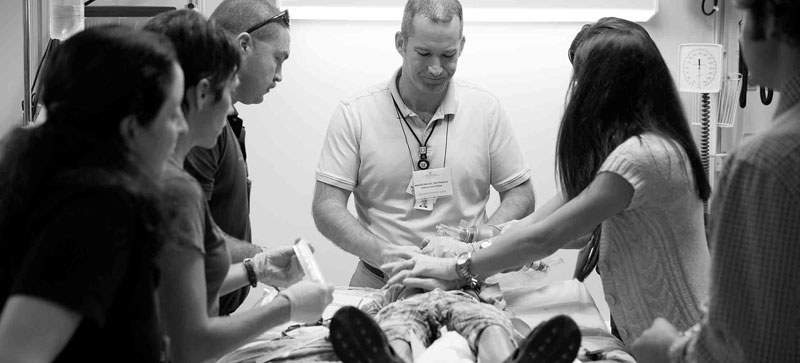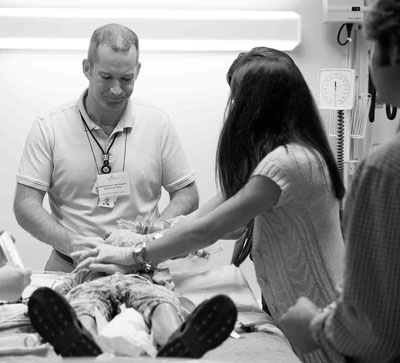Using Simulation to Build a Team

With the patient hemorrhaging blood, the smell of vomit wafting in the air, machines beeping loudly and adrenaline running high, simulation trainings have a way of bringing out the best and worst in people. They also make the perfect training ground for students. “The beauty of the simulations is that we can layer in all kinds of complexities,” says Maureen Keefe, Ph.D., R.N., professor and former dean of the College of Nursing.
During the 2012–2013 academic year, as part of a new, required interprofessional course, 873 of our medical, nursing, pharmacy, health and dentistry students participated in one of three different trainings at the Intermountain Healthcare Simulation Learning Center in the College of Nursing.
“I saw several students come into the scenario with a this-is-a-waste-of-my-time attitude,” says Jen Lazzara, a doctor of nursing practice student and teaching assistant for the Interprofessional Education course. “But during the debrief, they admitted they were surprised at how much they’d learned about how different roles contributed to the care team.”
Survey responses back up Lazzara’s observation. More than 80 percent of the students agreed with the statement, “I learned something useful about my health care colleagues during the Interprofessional Education activity.” And almost 90 percent agreed with the statement, “This Interprofessional Education activity will have a positive impact on how I interact with other disciplines when I am out in practice.”
Watching a video playback during the debriefing session provides each team member the opportunity to react to the team’s performance and talk honestly and critically about it. “It’s a brilliant way to learn,” says Keefe. “In the real world, you don’t have the luxury of stopping the action and replaying it.”
Students learn critical communication skills used routinely in other high-pressure industries, like air-traffic control and the military, and identify where communication breaks down. In health care, hesitating to speak up can lead to devastating mistakes. Studies estimate the number of patients killed every day from medical mistakes in the hundreds—the equivalent of one or more planes crashing daily. In a team-based clinical environment, everyone is empowered and encouraged to express concerns. And each professional role is viewed as bringing an important contribution to overall patient care.
Importantly, through simulation trainings, students begin to recognize that there’s not one right answer, one right way or one right expert. Rather it’s the diversity of thought, approach and knowledge of an entire group that they’ll need to navigate the complexities of human health and promote long-term healing. Knowing what to expect in your role enriches the learning experience and makes the transition to real patients much easier.



